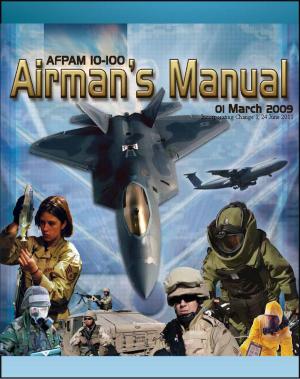Tactical Airlift: The United States Air Force (USAF) in Southeast Asia - Vietnam War, French War in Indochina, Air Commando, Special Forces, Khe Sanh, Tet, Air Force Caribous, Laos, Withdrawal
Nonfiction, History, Military, Vietnam War, Asian, Aviation| Author: | Progressive Management | ISBN: | 9781310991660 |
| Publisher: | Progressive Management | Publication: | August 14, 2015 |
| Imprint: | Smashwords Edition | Language: | English |
| Author: | Progressive Management |
| ISBN: | 9781310991660 |
| Publisher: | Progressive Management |
| Publication: | August 14, 2015 |
| Imprint: | Smashwords Edition |
| Language: | English |
Professionally converted for accurate flowing-text e-book format reproduction, this Air Force publication is a comprehensive history of tactical airlift in the Vietnam War era. Throughout the War in Southeast Asia, American and Vietnamese forces relied heavily on tactical airlift to satisfy the logistical demands of the conflict. While doctrine normally dictated the use of railroads and roads first to move supplies, there was simply no way other than aircraft to move quickly the necessary volume of men and materiel over difficult terrain that was subject to frequent interdiction by the enemy. Tactical airlift had to support simultaneously the full range of U.S. and Vietnamese activities: irregular forces, covert operations, remote outposts, and full-scale conventional operations involving thousands of men. And the support had to be provided despite shortages of aircraft and crews, bureaucratic inefficiency, and chronic scheduling problems.
The successful accomplishment of the mission was a testament to the skill and determination of those who flew and supported the thousands of transport sorties so vital to the allied effort. Theirs was a record of continual ingenuity and innovation in tactics, techniques, organization, and equipment. In total tonnage moved, Air Force tactical airlift in Southeast Asia very quickly exceeded previous efforts in the China-Burma-India theater in World War II, the Berlin Airlift, or the Korean War.
Tactical airlift matured in Vietnam. American airlift personnel worked with the French prior to their pull-out in the mid-1950s, and started assisting South Vietnamese in the years just prior to the massive American involvement. Tactics were developed, and then changed constantly in an effort to adapt to current military situations. Sometimes the old procedures did not apply. For example, the dropping of paratroops, long a staple of tactical airlift, was only marginally successful and in 1966 was largely abandoned in favor of helicopter-borne assault forces. But the early involvement in airborne assault did provide experience in supporting a seemingly endless variety of missions and helped shape the future of the airlift mission.
Part One: The Counterinsurgency Years, 1946-1964 * I. The French War in Indochina * II. The Troop Carrier Idea, 1954-1961 * III. Farm Gate and the Air Commando Tradition * IV. The Dirty Thirty and the Vietnamese Air Force Transport Arm * V. Mule Train - The First Year * VI. The Airlift System, 1963-1964 * VII. Air Supply of Special Forces * Part Two: The Years of the Offensive, 1965-1968 * VIII. The Entry of the C-130, 1965-1966 * IX. Search and Destroy * X. The Airlift System in Growth, 1966-1967 * XI. Junction City and the Battles of 1967 * XII. The Khe Sanh Campaign * XIII. Tet and the Battles of 1968 * XIV. The Air Force Caribous * Part Three: Other Applications * XV. The Auxiliary Roles * XVI. Airlift in Irregular Warfare * XVII. The War for Laos * Part Four: The Years of Withdrawal, 1969-1975 * XVIII. The Airlift System, 1969-1971 * XIX. The Campaigns of 1969-1971, Cambodia and the Panhandle * XX. The Caribou Force, 1969-1972 * XXI. The Easter Offensive—The Battle of An Loc * XXII. The Easter Offensive—The Countrywide Response * XXIII. The Advisory Role and the Vietnamese Air Force Airlift Arm * XXIV. Return to Cold War in Southeast Asia * XXV. The 1975 Denouement * XXVI. Reflections
Professionally converted for accurate flowing-text e-book format reproduction, this Air Force publication is a comprehensive history of tactical airlift in the Vietnam War era. Throughout the War in Southeast Asia, American and Vietnamese forces relied heavily on tactical airlift to satisfy the logistical demands of the conflict. While doctrine normally dictated the use of railroads and roads first to move supplies, there was simply no way other than aircraft to move quickly the necessary volume of men and materiel over difficult terrain that was subject to frequent interdiction by the enemy. Tactical airlift had to support simultaneously the full range of U.S. and Vietnamese activities: irregular forces, covert operations, remote outposts, and full-scale conventional operations involving thousands of men. And the support had to be provided despite shortages of aircraft and crews, bureaucratic inefficiency, and chronic scheduling problems.
The successful accomplishment of the mission was a testament to the skill and determination of those who flew and supported the thousands of transport sorties so vital to the allied effort. Theirs was a record of continual ingenuity and innovation in tactics, techniques, organization, and equipment. In total tonnage moved, Air Force tactical airlift in Southeast Asia very quickly exceeded previous efforts in the China-Burma-India theater in World War II, the Berlin Airlift, or the Korean War.
Tactical airlift matured in Vietnam. American airlift personnel worked with the French prior to their pull-out in the mid-1950s, and started assisting South Vietnamese in the years just prior to the massive American involvement. Tactics were developed, and then changed constantly in an effort to adapt to current military situations. Sometimes the old procedures did not apply. For example, the dropping of paratroops, long a staple of tactical airlift, was only marginally successful and in 1966 was largely abandoned in favor of helicopter-borne assault forces. But the early involvement in airborne assault did provide experience in supporting a seemingly endless variety of missions and helped shape the future of the airlift mission.
Part One: The Counterinsurgency Years, 1946-1964 * I. The French War in Indochina * II. The Troop Carrier Idea, 1954-1961 * III. Farm Gate and the Air Commando Tradition * IV. The Dirty Thirty and the Vietnamese Air Force Transport Arm * V. Mule Train - The First Year * VI. The Airlift System, 1963-1964 * VII. Air Supply of Special Forces * Part Two: The Years of the Offensive, 1965-1968 * VIII. The Entry of the C-130, 1965-1966 * IX. Search and Destroy * X. The Airlift System in Growth, 1966-1967 * XI. Junction City and the Battles of 1967 * XII. The Khe Sanh Campaign * XIII. Tet and the Battles of 1968 * XIV. The Air Force Caribous * Part Three: Other Applications * XV. The Auxiliary Roles * XVI. Airlift in Irregular Warfare * XVII. The War for Laos * Part Four: The Years of Withdrawal, 1969-1975 * XVIII. The Airlift System, 1969-1971 * XIX. The Campaigns of 1969-1971, Cambodia and the Panhandle * XX. The Caribou Force, 1969-1972 * XXI. The Easter Offensive—The Battle of An Loc * XXII. The Easter Offensive—The Countrywide Response * XXIII. The Advisory Role and the Vietnamese Air Force Airlift Arm * XXIV. Return to Cold War in Southeast Asia * XXV. The 1975 Denouement * XXVI. Reflections















